Calvados Guide: The Normandy Coast
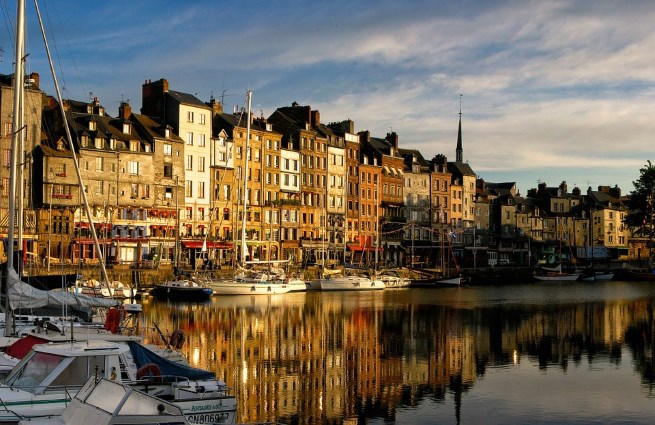
France Today takes a tour around this department
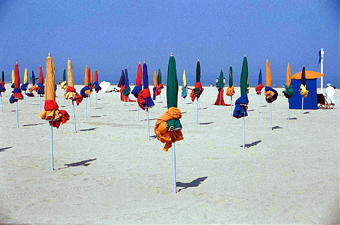
With so many contrasting landscapes, exploring the Calvados département in Normandy is like flicking through a glossy nature book. The northern coastline is rugged and beautiful, the Pays d’Auge is a peaceful farming plain where church steeples appear on every horizon and the rocky Suisse Normande echoes to the sound of white-water rapids and horses’ hooves. Normandy cows, the source of famously rich butter and cheese, graze the meadows, while huge apple orchards yield the raw material for a gamut of Calvados’ fruity drinks. The sea also offers up its own rewards, as the freshest seafood finds its way into every restaurant.
Calvados is no place for calorie counting. The produce here, be it from the sea or the land, will, at some stage, find itself bathing in a rich and invariably apple-infused creamy sauce. La Table et le Terroir restaurant in central Bayeux, for instance, serves up typically no-nonsense (and indulgent) Norman classics such as Pork braised in pommeau (apple liqueur) and cream. This relaxed, low-ceilinged establishment sits next to a renowned purveyor of fine local meats. Anyone eating here is advised to partake in a tot of Calvados (apple brandy) between belt-busting courses, known as ‘le trou normand’. This mid-meal digestif will leave diners more inclined, indeed able, to stroll across the courtyard and join the crowds surveying the town’s showpiece Bayeux Tapestry, which famously depicts William the Conqueror’s 1066 defeat of the English.
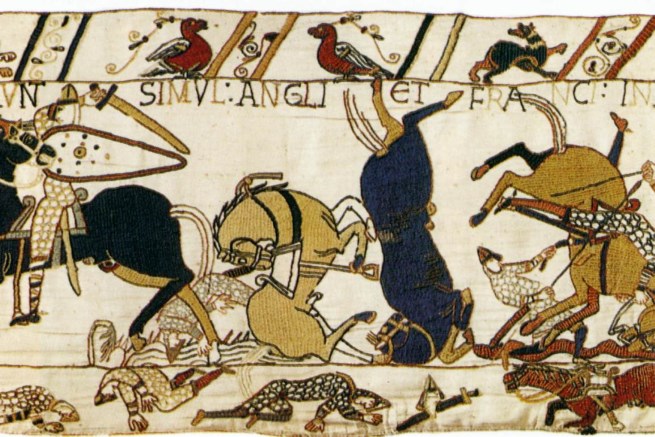
Bayeux Tapestry
Along the Côte Fleurie at one of Trouville’s many superb seafront brasseries, the fish is so spankingly fresh it appears to have jumped from the harbour into the frying pan. Les Voiles is a popular choice for film stars appearing at the Deauville American Film Festival and provides sumptuous mussel, salmon and cod dishes at reasonable prices. The place is full of illustrations by legendary local artist Savignac, who also designed the town’s promotional posters. All produce cooked here is unloaded daily in the harbour and sold at the town’s excellent fish market, which is a spectacle in itself.
When in Caen, Café Bois Charbon is the place to go for a warm welcome and great local produce. Situated on the Port du Plaisance, the lively, family-friendly atmospere here enhances the simple, tasty specials filet de hareng (herring fillet) and duopavé au maigret (duck fillet with sirloin). Galettes – pancakes filled with either sweet or savoury ingredients – are a cheap, quick and filling alternative to a full-blown lunch. Pork, veal, foie gras, cheese (famous local cheeses are Livarot and Pont l’Eveque) and butter all play crucial roles in the cuisine of the region.
Despite being one of France’s rare non-wine-producing regions, drinking well is important in these parts. For anyone seeking an authentic taste of the region, no trip is complete without visiting a Calvados producer. Pierre Huet, a fifth-generation aficionado and expert who lives in a manor house near Cambremer, offers an enthusiastic guided tour and the chance to sample (and buy) all manner of apple products, including cidre bouché (fizzy cider) and pommeau. His raison d’être, though, is to make superb Calvados by using up to 300 kinds of apples and following a finely honed process that lasts anywhere from three to 50 years. Although pears and cherries make their way onto most menus, apples are the definitive fruit of the region, and here their usage has become an art form.
See conventional art in Honfleur, the pretty fishing town up the coast from Trouville. Many galleries showcase local artists’ work along the harbourside and in the narrow streets, while the ancient wooden church of Sainte-Catherine and the two huge greniers à sel (salt stores), used to preserve fish in the 17th century, offer a glimpse of the town’s long history – it was once an important departure point for maritime expeditions. For a modern perspective, visit the inventive and fun museum dedicated to Eric Satie, the composer and surrealist who was born in the port.
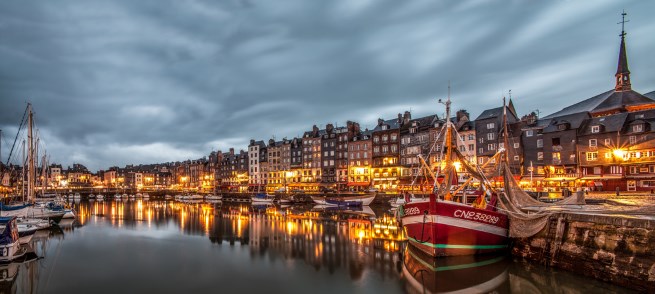
Honfleur, photo: Andrés Nieto Porras
Even Basil Fawlty would be hard pushed not to mention the war in Calvados, such is its all-pervading presence. The scarred beaches of Arromanches and Pointe du Hoc are essential stop-offs before repsects are paid at the vast American Cemetery at Colleville-sur-Mer and the more understated British Cemetery at Bayeux. Caen, the administrative capital of the region, makes a good base for exploring the coast and varied landscapes of the Pays d’Auge, Suisse Normande and Falaise regions inland. The city was hammered during the war, but many beautiful buildings remain, including the two great abbeys built by William the Conqueror. The château and Musée des Beaux Arts make for an interesting morning’s sightseeing, while important viewing for all the family is the Caen Memorial, a stylish museum that offers a poignant and unsentimental perspective of D-Day events.
Deauville and Trouville, separated only by the Le Touques river, offer altogether lighter relief. The former has an air of exclusivity and a certain swagger. Founded as France’s first seaside resort by Napoléon III’s cousin, the Duke of Morny, in 1861, the town remains heaven for those with spending power. Top fashion houses Hermès and Louis Vuitton provide some glamourous shopping opportunities and the splendid casino on the seafront lets you part with your cash in a grand way. The boardwalk that stretches for 500 metres along the beach is lined with white fences stencilled with the names of the US film stars who have attended the town’s film festival over the years, while the beach itself comprises fine, pristine sand punctuated only by multi-coloured umbrellas and expensively tanned sunbathers. The town’s high profile is maintained by the horseracing, polo and showjumping events that form the backbone of high society’s calendar. The year’s most important meetings take place in July and August, but during the closed season visitors can browse the stables, workshops and auction houses around the town’s central hippodrome (racetrack). Horses play a big part in sustaining the rural economy of Calvados, as well, and élevage (breeding) stables in the Pays d’Auge welcome visitors.
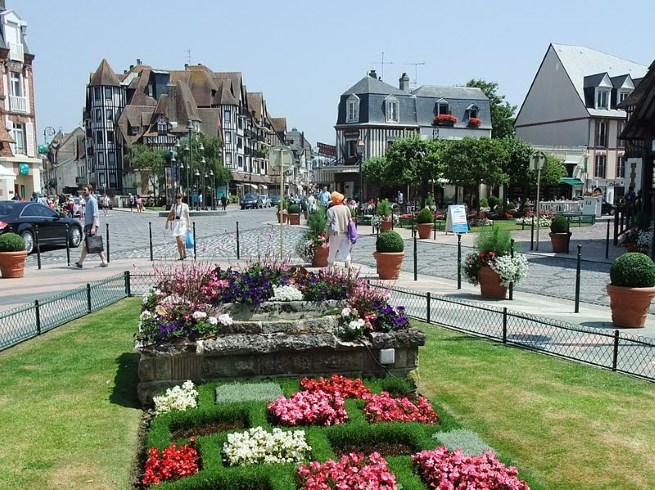
Deauville, photo: by Nikater via Wikimedia Commons
Deauville is Trouville after a lottery win, but the latter has bags of charm to compensate. Trouville is a much less showy affair. A working fishing port, the bustling quayside and windy backstreets provide great opportunities for soaking up some small-town atmosphere, while the beach, lined with extraordinary villas, each unique, is a fine choice for summer sunning should you wish to avoid the posers at Deauville. The town represents the essence of Calvados – simple pleasures enjoyed at a leisurely pace in old-world surroundings.
GETTING THERE
FERRY
Brittany Ferries sails overnight from Portsmouth to Caen. For details of bookings and other information on tours and packages in Calvados. call 08705 360360.
GETTING AROUND
For details of local train routes contact Rail Europe (08705 848848).
CLIMATE
Calvados enjoys the same conditions as southern England. Coastal regions are cooler during summer than inland.
OUTINGS
Honfleur: Maisons Satie (67 blvd Charles V; +33 2 31 89 11 11; for tours with headphones and narration. The Musée des Beaux-Arts (+33 2 31 30 47 70) in the grounds of the château in Caen city centre is free on Wednesdays, otherwise there is an entrance fee. Works included are by Titian and Rembrandt. The Bayeux Tapestry. For details of horse races at the Deauville Hippodrome contact the local Tourist Office.
Share to: Facebook Twitter LinkedIn Email
Leave a reply
Your email address will not be published. Required fields are marked *



